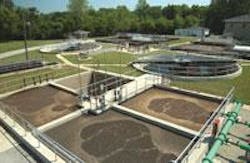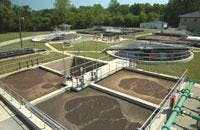Solids Reduction Process Lowers Biosolids Production
The new Cannibal™ solids reduction process from USFilter Envirex Products can virtually eliminate biosolids wasting in wastewater treatment plants. The process constantly recycles mixed liquor from an activated sludge process to a facultative sidestream bioreactor with limited oxygen.
Within the bioreactor, aerobic bacteria are selectively destroyed and slower growth bacteria break down their remains and byproducts. This interchange recycle flow between the bioreactor and the activated sludge process continues until the biosolids are completely broken down and destroyed. Only trash, inerts and grit are removed from the plant.
The reduction in biosolids accomplished by the Cannibal™ process can lead to capital and operational cost savings for both new and existing wastewater treatment plants.
Plants fitted with the process only require headworks, aeration tanks, final clarifiers, disinfection and customized interchange bioreactors with a solids separation module fitted onto the recycle line. This eliminates sludge thickening and dewatering equipment, sludge storage and holding tanks, and anaerobic to aerobic digesters, as well as additional costs associated with polymer feed equipment. The process can reduce the installed cost of the plant by as much as 40 percent.
Facilities that use the process can reduce operating costs with the reduction or the complete elimination of operational costs associated with sludge holding, digestion and dewatering facilities. In addition, sludge hauling and final sludge disposal costs are significantly reduced with only trash, grit and inerts being removed from the plant. The amount of savings varies by project and depends on solids handling requirements and costs.
The recycle flow rate between the activated sludge process and the Cannibal™ process' reactor tanks is important to the system's successful operation, and is custom-designed for each specific project. Specialized screens and cyclones on the return sludge line make up a solids separation module that prevents the buildup of non-biodegradable and non-volatile materials. Operation and control of the activated sludge process does not change with the inclusion of the process into the flow sheet.
Since biosolids are not wasted from the plant, sensitive nitrifying bacteria are maintained in the facility and are not lost through the wasting process. This provides a very stable nitrification performance, even in very cold climates, and also allows smaller aeration volumes to be used for design. Facilities using the process achieve high-quality effluent in terms of settling characteristics, BOD, TSS and ammonia removal. In addition, significant denitrification can occur in the process, to meet even the most stringent total nitrogen limits.

